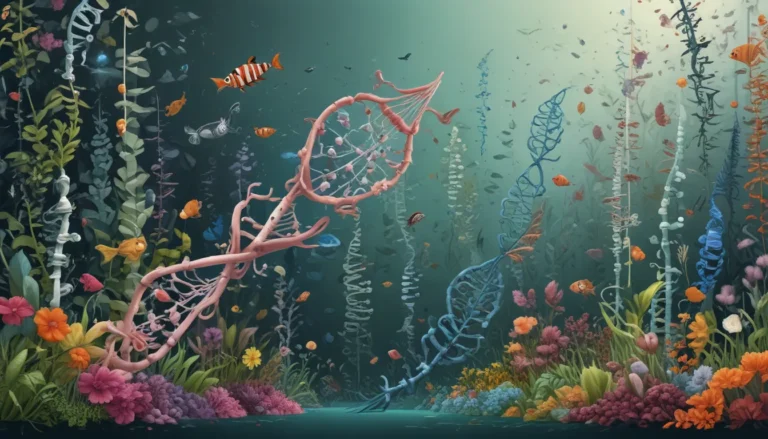A Note About Images: The images used in our articles are for illustration purposes only and may not exactly match the content. They are meant to engage readers, but the text should be relied upon for accurate information.
Are you ready to embark on a journey into the astonishing realm of convergent evolution? This captivating phenomenon reveals nature’s ingenious solutions to common challenges faced by diverse species on Earth. From wings in birds, bats, and insects to sophisticated visual systems in octopuses and vertebrates, convergent evolution showcases the remarkable adaptability of life forms.
Understanding Convergent Evolution
Convergent evolution is a mesmerizing concept that showcases how nature has a way of finding similar solutions to the same problems, even in unrelated species. This phenomenon occurs when different organisms independently develop similar characteristics or traits to adapt to similar environmental conditions or lifestyles. Contrary to popular belief, convergent evolution is not limited to a specific group of organisms but can be observed in various species, including mammals, birds, insects, and plants.
The Diversity of Convergent Evolution
One of the most intriguing aspects of convergent evolution is its occurrence across a wide range of organisms. From desert-dwelling mammals to blood-feeding creatures, the examples of convergent evolution are as diverse as the species themselves. This phenomenon challenges the notion of a linear progression in evolution, highlighting the complex and interconnected nature of life on Earth.
Analogous Structures in Convergent Evolution
Analogous structures are organs or body parts that serve similar functions but do not share a common evolutionary origin. This concept is exemplified in organisms like bats and birds, which have independently evolved wings to enable flight despite belonging to different evolutionary lineages. The development of analogous structures demonstrates nature’s creative and adaptive power in responding to environmental challenges.
Convergent Evolution on a Molecular Level
While physical structures are commonly associated with convergent evolution, the phenomenon can also occur at a molecular level. DNA sequences and protein structures in different species can evolve independently to perform similar functions, showcasing the versatility and complexity of evolutionary processes.
Fascinating Examples of Convergent Evolution
Let’s dive into the mesmerizing world of convergent evolution and explore some of the most compelling examples that illustrate nature’s remarkable adaptability and ingenuity.
Dolphins and Sharks: A Tale of Convergence
Despite their distinct evolutionary histories, dolphins and sharks have evolved similar streamlined body shapes, fin placements, and efficient swimming abilities to thrive in their aquatic environments. This striking convergence highlights nature’s ability to find optimal solutions for survival in diverse habitats.
Sugar Gliders and Flying Squirrels: Gliding in Harmony
The sugar gliders of Australia and the flying squirrels of North America may not be closely related, but they have both developed a remarkable ability to glide through the air using flaps of skin between their limbs. This convergence in gliding behavior showcases how unrelated species can independently evolve similar adaptations to navigate their environments.
Insects Mimicking Plants: A Camouflaged World
Insects like walking sticks and leaf insects have evolved strikingly similar appearances to the plants they inhabit, providing them with effective camouflage to evade predators. This convergence in physical appearance highlights the evolutionary advantage of blending in with surroundings to ensure survival in the wild.
Octopuses and Vertebrates: A Visionary Convergence
Octopuses and vertebrates, including humans, have independently evolved sophisticated camera-like eyes for efficient visual perception, despite belonging to different branches of the animal kingdom. This convergence in visual systems underscores the adaptive nature of sensory organs in response to environmental demands.
Cacti and Euphorbias: Surviving the Desert
Cacti in North America and Euphorbias in Africa have independently evolved similar characteristics, such as succulent stems and reduced leaves, to thrive in arid environments. This convergence in desert plant adaptations highlights nature’s creative solutions to the challenges posed by harsh ecological conditions.
The Implications of Convergent Evolution
Convergent evolution not only enriches our understanding of biodiversity but also provides valuable insights into the power of natural selection and adaptation. By studying how diverse species independently arrive at similar solutions, scientists can uncover the mechanisms driving evolutionary processes and apply them to various fields, including conservation and technology.
Applications Beyond Biology
The study of convergent evolution extends beyond biological sciences and holds implications for disciplines like engineering and design. By drawing inspiration from nature’s solutions to common challenges, researchers can innovate new technologies and solutions that mimic the efficiency and effectiveness of biological adaptations.
Conclusion: Embracing the Marvels of Convergent Evolution
In conclusion, the captivating phenomenon of convergent evolution unveils the awe-inspiring adaptability and interconnectedness of life on Earth. Through a myriad of examples ranging from physical structures to behavioral traits, convergent evolution showcases nature’s boundless creativity in responding to environmental pressures. As we continue to unravel the mysteries of evolutionary processes, convergent evolution stands as a testament to the ingenuity and resourcefulness of life on our planet.
Expand Your Knowledge with Convergent Evolution
Are you ready to delve deeper into the mesmerizing world of convergent evolution? Explore the remarkable examples of parallel evolution and discover the interconnectedness of diverse species across the globe. Convergent evolution invites you to marvel at the brilliance of nature’s adaptive solutions and gain a newfound appreciation for the complexity of life on Earth.
Join Us in Exploring the Wonders of Convergent Evolution
Dive into the captivating realm of convergent evolution and witness the extraordinary adaptations that diverse species have independently developed. Uncover the interconnectedness of life forms across different habitats and discover the remarkable parallels in evolutionary outcomes. Convergent evolution awaits your exploration, offering a glimpse into the intricate and ingenious ways in which nature shapes the world around us.






